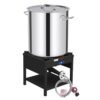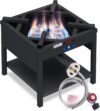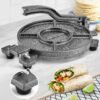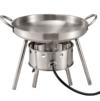The magic of outdoor living often revolves around a central hub: a reliable gas camping stove. With so many options available, how do you choose the perfect companion for your adventures? This guide will help you make an informed decision.
Step 1:Define Your Needs—Where Will You Cook?
Large Gatherings & Commercial Use:
If you’re cooking for a crowd or running an outdoor food stall, a high-output (100,000+ BTU), heavy-duty cast iron burner is the professional choice. It delivers powerful, consistent heat for tasks like stir-frying or preparing large batches of food.
Backyard Parties & Family Car Camping:
For those who drive to a campsite with ample trunk space, a powerful dual-burner stove with a thoughtful design is ideal. It allows you to sauté and simmer simultaneously, transforming your campsite into an efficient outdoor kitchen. A model like a 68,000 BTU dual-burner stove is the “gold standard” for this scenario.
Fishing, Picnics & Tailgating:
Speed, convenience, and instant gratification are key. A portable stove that requires no complicated assembly and fits easily in your car trunk allows you to enjoy hot meals with greater ease.
Step 2: Deciphering the Key Specifications
1. Power Output (BTU)
BTU (British Thermal Unit) measures heat output. Higher BTU means faster heating times. Your choice depends on your cooking style:
Commercial-Grade Power (100,000+ BTU):
Ideal for large gatherings or commercial use requiring rapid cooking, like deep-frying or quick stir-fries. An output of 200,000 BTU signifies incredible heating speed for large volumes of food.
Efficient Family Camping (30,000 – 68,000 BTU):
This is the sweet spot for family camping. It offers a perfect balance, providing enough power to boil water rapidly and handle frying duties efficiently without excessive fuel consumption.
2. Build Materials & Durability: Cast Aluminum vs. Stainless Steel
The material determines the stove’s lifespan and suitability for different environments. This is a critical differentiator.
Heavy-Duty Cast Aluminum Body:
This material offers excellent durability and heat dissipation. It is lighter and provides great resistance to rust, making it a high-value choice for most standard camping and backyard uses.
304 Grade Stainless Steel Body:
304 stainless steel offers superior corrosion and rust resistance, easily standing up to humid, salty coastal air or the wear and tear of frequent use. It is more robust, easier to clean, and has a premium look and feel, making it the top choice for those seeking maximum longevity and performance in harsh conditions.
Heavy-Duty Cast Iron Burner:
The hallmark of a professional-grade stove. Cast iron is thicker, more heat-resistant, and less prone to deformation than ordinary steel, ensuring a long service life and consistent high performance.
3. Burner Count & Layout: Single-Burner Efficiency vs. Dual-Burner Versatility
The number of burners dictates the efficiency and functionality of your outdoor kitchen.
Single-Burner Stoves: The Minimalist’s Choice.
Fuel Efficiency & Focus: With only one burner, all fuel is directed to a single point, making them highly efficient. They fulfill the most basic and essential needs perfectly.
Budget-Friendly: Typically more affordable, they are an ideal entry point for those on a budget or who camp occasionally.
Three-burner Stoves: The Mobile Kitchen for Outdoor Chefs.
Cooking Efficiency & Flexibility: Three burners provide unparalleled freedom. You can sear steaks while blanching vegetables, or use a wok, a pan and a stockpot simultaneously—just like cooking at home. This is ideal for family camping or group gatherings.
Independent Precision Control: Each burner usually has its own control valve, allowing you to precisely adjust the heat for different dishes (a gentle simmer or a vigorous boil), dramatically improving the quality of your outdoor meals.
4. Ignition Systems: Push-Button Start or Manual Reliability
The ignition system is your first point of interaction and affects user experience.
Piezo Ignition: The Convenience Option.
How it works: Pressing a button causes an internal mechanism to strike a piezoelectric crystal, creating a spark that lights the gas.
Benefits: Extremely convenient—no need for a separate lighter or matches—true “turnkey” operation. This is especially valuable in windy weather or when your hands are full. This is now the standard feature on modern camping stoves.
Consideration: In very damp conditions or after long periods of use, the igniter might occasionally need to be dried for optimal performance. Nonetheless, it offers significant convenience.
Manual Ignition: The Reliable Backup.
How it works: Requires an external flame source, like a long-reach lighter, BBQ lighter, or even a match.
Benefits: The mechanism is simple and almost never fails. If the piezo igniter ever doesn’t work, manual ignition is a perfectly reliable backup. Many outdoor enthusiasts carry a lighter as a backup out of habit.
Pro Tip: For manual ignition, always open the gas valve first, then immediately apply the flame to avoid gas buildup. Using a long-reach lighter is recommended for safety.
Essential Safety Tips
- Always use in a well-ventilated outdoor area, away from tents, vehicles, and other flammable materials.
- Before use, inspect the gas hose and connections for damage, cracks, or wear.
- Always place the stove on a flat, stable surface.
- Always follow the manufacturer’s instructions for connecting and disconnecting the fuel tank.
- Never leave the stove unattended while in use. Keep children and pets at a safe distance.
- After use, ensure the gas valve is fully closed. Allow the stove to cool completely before handling or storing.
Choosing the right outdoor stove is the first step to unlocking countless memorable adventures. We hope this guide helps you choose the perfect model for your next journey into the great outdoors with confidence.













